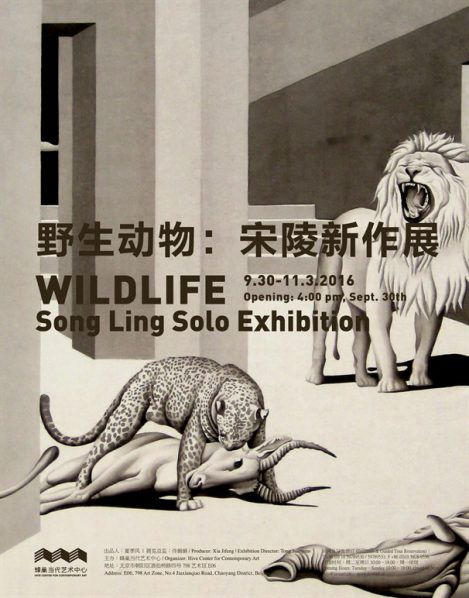
Hive Center for Contemporary Art is honored to announce the opening of Wildlife: Song Ling Solo Exhibition, which will launch at 4:00p.m. on 30th Sept. 2016. The exhibition will show Song Ling's new works of the recent years, from when he came back to organize his respective exhibition in China and establish his studio in Hanghzou from Australia, in 2013. The exhibition will last until Nov. 3, 2016.
In 2014, Ghosts in the Mirror, Song Ling's first retrospective exhibitionwas organized in Today Art Museum(Beijing), with its full success, the exhibition, comprised roughly 200 artworks and large amounts of documentary materials spanning three decades’ artistic career of Song Ling, had the second show in Zhejiang Museum(Hangzhou). Song Ling was born in Hangzhou in 1961, and graduated from Zhejiang Academy of Art in 1984. His series People-Pipelines was featured in ’85 New Space, one of the most important exhibitions of the ’85 New Wave art movement. These works used Surrealist techniques to prophet the human contradictions of the era of industrialization. In 1986, he joined Zhang Peili, Geng Jianyi and others to found the Pond Association. At the same time, Song Ling also reached a high point in his individual creations. Between 1986 and 1987, he created a series of ink paintings entitled Meaningless Choice? In this series, Song Ling absorbed and incorporated the expressive forms and linguistic traits of photography to create numerous reproductions of the same image (mostly livestock). This approach calls to mind Walter Benjamin’s critique on the work of art in the age of mechanical reproduction. The artist’s depictions of these animals can also be seen as depictions of people: in the era of industrial technology and mechanical cultivation, man and livestock share the same fate. After 1987, as the tumultuous ’85 New Wave art movement was approaching its close, Song Ling left China to study and live in Australia. Once in Australia, he continued with his already-formed unique individual style. Aside from ink painting, he also experimented with mixed-media collage, acrylic and other mediums, 12 solo exhibitions had been organized. During his residence in Australia, Song has concerns about Chinese contemporary scene as always, and he returned to Hangzhou to set up a studio in 2013.
Song Ling’s works since 2013 include series like “The Instrument”, “Nightwalker”, “Scull”, “Dead Bird” and the “Wildlife” series in the past two years; by extracting the vital heat of every object, Song Ling captures all the rare, vanishing secrets in the cold and lonesome darkness. The portrayed parts in the “The Instrument” series are similar morphologically to the images in other “animal” – related series, both being sharp, thinly brittle, de-thermalized, and delicate in structure. In his “animal” – related series, the animal or the skeleton is placed in the center of the picture, with a faded background, without warmth, feelings or breaths, through which Song Ling tries to elicit thoughts on aesthetic issues about time and space, life and death, evanescence and eternity, clarity and obscurity, etc.
In the “Wildlife” series, the depicted objects appear to be put on a stage as well as in a trap. Viewers go beyond the peeping angle set by Song Ling to the far-away original environment behind them. It’s easy for eyes to trace their roots out of the trap, but the wild animals can only be limited in the virtual field of the foreground, and the picture is filled with a mood cold as machinery, betraying imagination and distortion. Some of Song’s works take on the tone of grey and blue, while “Cruel/Devour” in “Wildlife”, his latest large quintuplet, turns out to be depicted in the color of ink which is devoid of feelings; the scenario of “Cruel/Devour” is more complicated and dramatic, and the color of ink is employed to give a cold and lonesome noise to the environment.
In the “Wildlife” series, the depicted objects appear to be put on a stage as well as in a trap. Viewers go beyond the peeping angle set by Song Ling to the far-away original environment behind them. It’s easy for eyes to trace their roots out of the trap, but the wild animals can only be limited in the virtual field of the foreground, and the picture is filled with a mood cold as machinery, betraying imagination and distortion. Some of Song’s works take on the tone of grey and blue, while “Cruel/Devour” in “Wildlife”, his latest large quintuplet, turns out to be depicted in the color of ink which is devoid of feelings; the scenario of “Cruel/Devour” is more complicated and dramatic, and the color of ink is employed to give a cold and lonesome noise to the environment.
Over the past few decades, Song’s art has witnessed the Western cultural ideas and art ecology being reshaped and the innovative turn of the human world into an age of multimedia information, and in his experimentation on many other mediums, he has never put aside ink and wash, the narrative manner of his ideas and visual logic. In his new creations, the wild animals, fighting at close quarters, roaring with anger, or tripped over, de-thermalized at the center of the stage, fill the virtual space of materialism in this consumer age with noise and coldness; in this way, the narration in ink and wash may have helped settle some warmth and created an imbalance of perfect subtlety.
About the exhibition
Dates: Sep 30 - Nov 03, 2016
Venue: Hive Center for Contemporary Art
Courtesy of the artist and Hive Center for Contemporary Art, for further information please visit www.hiveart.cn.




























